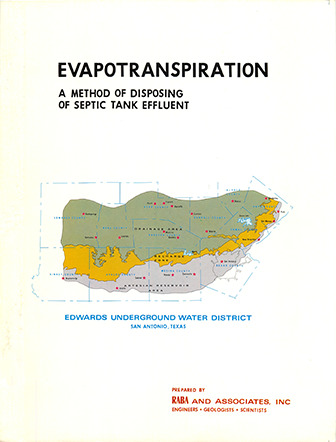Evapotranspiration – A Method of Disposing of Septic Tank Effluent

| Author | Rugen MA, Lewis DA and Benedict IJ |
| Year | 1977 |
| Description | Feasibility study for evapotranspiration as an effective means of disposing septic tank effluent |
| Report Number | G 75-185 |
| Publisher | Raba and Associates, Inc |
| Location | Edwards Aquifer Recharge Zone, Bexar County |
| Cover | View Download |
| File | View Download |
| Summary |
|
The Edwards Aquifer, an extensive formation of limestone and dolomite extending over a vast portion of central Texas, is the sole source of water for over 1,000,000 people. Its Recharge Zone, encompassing all or parts of some nine counties, is particularly vulnerable to contamination if population growth and property development continues to the north of the metropolitan areas which are on or adjacent to the zone. While the septic tank-soil absorption system is a valuable and popular method of disposing of domestic household sewage, this and other traditional methods of sewage disposal are not suitable in this instance because of the geology of the Recharge Zone and very thin soil cover. After an extensive search of the literature, RABA AND ASSOCIATES, CONSULTING ENGINEERS, INC., petitioned the Edwards Underground Water District for its support and funding to develop design criteria for the construction and installation of a viable alternative to the traditional methods of septic tank effluent disposal. This alternative was the evapotranspiration process. Beginning in July, 1975, and extending over a period of two years, a multi-discipline team of researchers investigated and obtained design parameters at an experimental site located in north Bexar County, Texas, an area which is a part of the Recharge Zone. While it was known that investigations had been made of evapotranspiration by others, the majority of this prior research was directed toward studying water loss via this process but with an eye to conserving water. This project was designed to study the opposite view. Here, by encouraging water loss from a set of test tanks, insight was gained into means of utilizing this loss to remove fluid wastes deposited in the system from a septic tank. The principle. conclusion drawn from this study is that evapotranspiration is a viable alternative to traditional methods of sewage disposal in areas of very low permeability or areas with extremely high permeability in which underground aquifers may be endangered. The design criteria sought have been established although more study is needed to refine and improve certain aspects of the procedure. As a result of the present work, it is now possible to determine with reasonable accuracy the surface area needed to permit the installation and proper functioning of an evapotranspiration system. |
Search for Documents
Advance Search
Explore EAA's Scientific Reports
- All Reports
- Groundwater Recharge, Recharge Zone
- Groundwater Movement
- Geomorphology and Caves
- Weather Modification
- Geology
- Water Use and Conservation
- Geochemistry
- Water Resources Planning and Management
- Floods and Drought
- Water Quality
- Climatology
- Surface Water / Groundwater Relationship
- Biology
- Springs, Groundwater Discharge
- Archaeology
- RZ Protection
- Aquifer Levels
- Remote Sensing
- Precipitation
- Overview Studies
- Modeling
- Hydrology and Hydrogeology
- History
